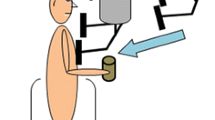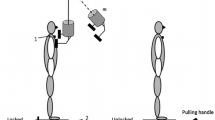Summary
The influence of altered plantar support area on the compensatory reactions to forward fall was studied. The forward fall was provoked from an initial forward inclined posture, and balance was recovered by making steps. Alteration of the support area was unilateral and was obtained using two rods on which the subject stood. The rods were under either the starting foot or the stance foot. The configuration of the plantar support area, flat or reduced, did not change the latency of Soleus electromyographic activity. In contrast, the unilateral reduction of the plantar support area had powerful bilateral effects on the magnitude of Soleus activity. The reduction of the plantar support area on the swing side significantly reduced the ipsilateral Soleus response. The reduction of plantar support area on the stance side did not alter the initial part of the ipsilateral soleus response, but did change the late response (corresponding to the unipedal stance). Reduction of plantar support surface area resulted in earlier step execution and earlier heel-contact, i.e. faster balance recovery. These changes suggest that there is an integration of the spinal reflexes, as well as the stepping motor program.
Similar content being viewed by others
References
Andersson O, Forssberg H, Grillner S, Lindqvist M (1978) Phasic gain control of the transmission in cutaneous reflex pathways to motoneurones during “fictive locomotion”. Brain Res 149: 503–507
Bathien N, Hugon M (1964) Etude chez l'homme de la dépression d'un réflexe monosynaptique par stimulation d'un nerf cutané. J Physiol (Paris) 56: 285–286
Brenière Y, Do MC, Sanchez J (1981) A biomechanical study of the gait initiation process. J Fr Biophys Méd Nucl 5: 197–206
Castaigne P, Cathala HP, Pierrot-Deseilligny E, Bussel B, Truelle JL, Deloche G (1973) Influence des stimulations cutanées d'intensité variable sur l'amplitude et la variabilité du réflexe H chez l'homme normal. Electroenceph Clin Neurophysiol 3: 193–201
Crenna P, Frigo C (1984) Evidence of phase dependent nociceptive reflexes during locomotion in man. Exp Neurol 85: 336–345
Delwaide PJ, Crenna P, Fleron MH (1981) Cutaneous nerve stimulation and motoneuronal excitability after ipsilateral and contralateral nerve stimulation. J Neurol Neurosurg Psychiat 44: 699–707
Dietz V, Berger W (1982) Spinal coordination of bilateral leg muscle activity during balancing. Exp Brain Res 47: 172–176
Dietz V, Quintern J, Berger W (1985) Afferent control of human stance and gait: evidence for blocking of group I afferents duringgait. Exp Brain Res 61: 153–163
Do MC, Brenière Y, Brenguier P (1982) A biomechanical study of balance recovery during the fall forward. J Biomech 15: 933–939
Do MC, Brenière Y, Bouisset S (1988) Compensatory reactions in forward fall: are they initiated by stretch receptors? Electroenceph Clin Neurophysiol 69: 448–452
Do MC, Bussel B, Brenière Y (1990) Influence of plantar cutaneous afferents on early compensatory reactions to forward fall. Exp Brain Res 79: 319–324
Duysens J (1977) Reflex control of locomotion as revealed by stimulation of cutaneous afferents in spontaneously walking premammillary cats. J Neurophysiol 40: 737–751
Duysens J, Pearson KG (1976) The role of cutaneous afferents from the distal hindlimb in the regulation of the step cycle of thalamic cats. Exp Brain Res 24: 245–255
Eccles RM, Lundberg A (1959) Synaptic actions in motoneurones by afferents which may evoke the flexion reflex. Arch Ital Biol 97: 199–221
Forssberg H (1979) Stumbling corrective reaction: a phase depen- dent compensatory reaction during locomotion. J Neurophysiol 42: 936–953
Holmqvist B (1961) Crossed spinal reflex actions evoked by volleys in somatic afferents. Acta Physiol Scand 52, Suppl 181: 1–67
Holmqvist B, Lundberg A (1961) Differential supraspinal control of synaptic actions evoked by volleys in the flexion reflex afferents in alpha motoneurons. Acta Physiol Scand 54, Suppl 186: 1–51
Horak FB, Nahsner LM (1986) Central programming of postural movements: adaptation to altered support-surface configurations. J Neurophysiol 55: 1369–1381
Rossignol S, Lund JP, Drew T (1988) The role of sensory inputs in regulating patterns of rhythmical movements in higher vertebrates: a comparison between locomotion, respiration and mastication. In: Cohen A, Rossignol S, Grillner S (eds) Neural control of rhythmic movements in vertebrates. Wiley and Sons, New York, pp 201–283
Author information
Authors and Affiliations
Rights and permissions
About this article
Cite this article
Do, M.C., Roby-Brami, A. The influence of a reduced plantar support surface area on the compensatory reactions to a forward fall. Exp Brain Res 84, 439–443 (1991). https://doi.org/10.1007/BF00231467
Received:
Accepted:
Issue Date:
DOI: https://doi.org/10.1007/BF00231467




